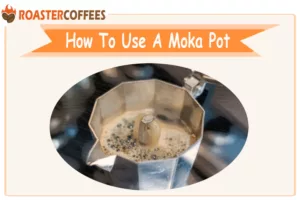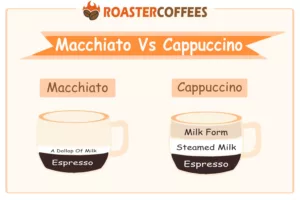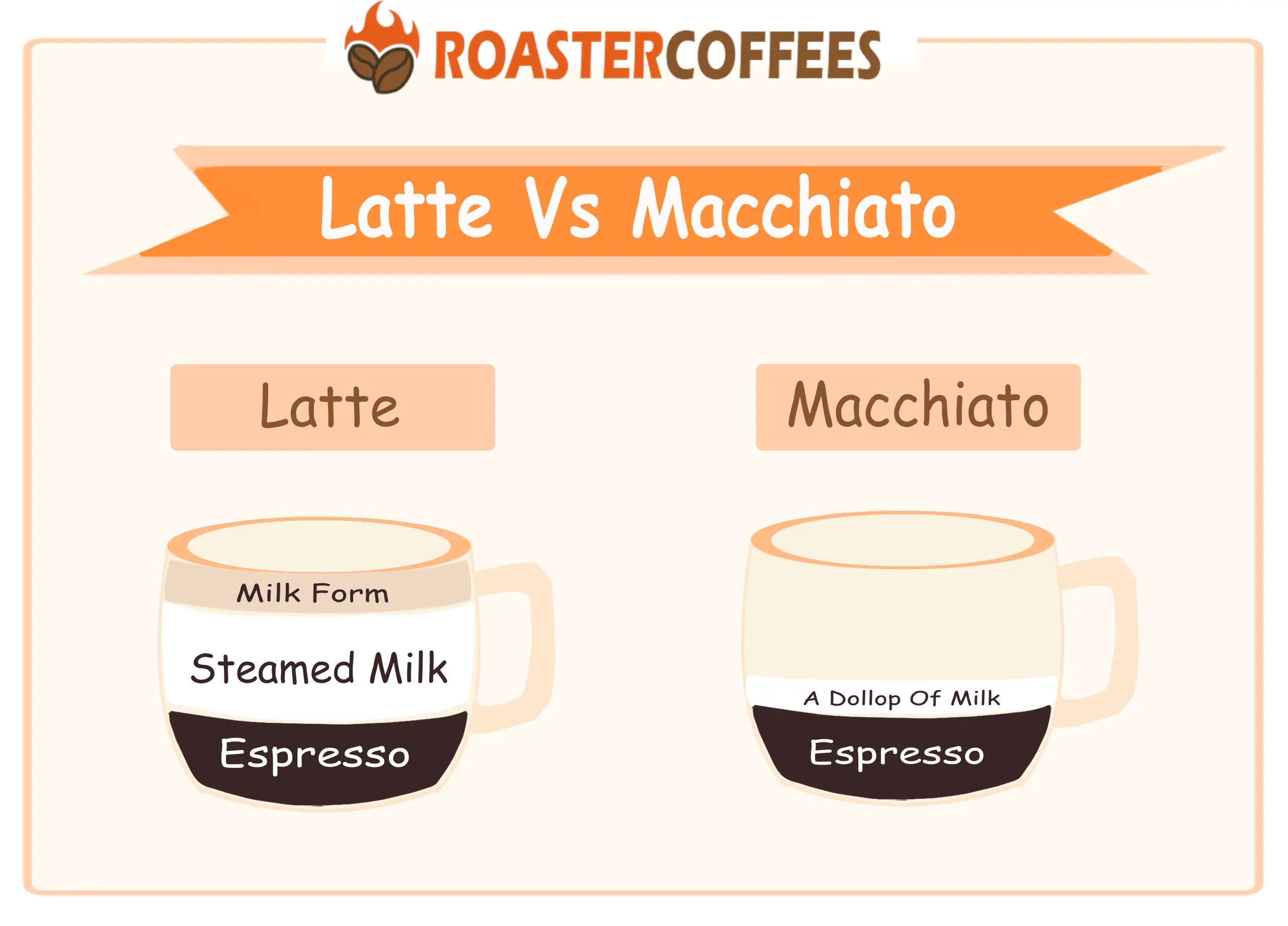
What are the exact differences between espresso-based drinks? A familiar example, latte vs macchiato.
When you sit in your favorite coffee shop and browse the menu for an espresso-based beverage, it is easy to get confused and eventually default to your usual order.
As coffee chains become more relaxed in their interpretation of classic coffee beverages, it is more challenging than ever to distinguish between different espresso-based drinks.
If you want to order macchiato from some coffee chains, you may get a syrupy drink, which is a far cry from traditional espresso macchiato.
This phenomenon has caused problems for some specialty coffee shop owners. It makes those who try to walk out of the coffee chain feel alienated in the local coffee shop, thus returning to the coffee chain.
Please continue. This article will help you eliminate misunderstandings about two popular beverages based on espresso: latte vs macchiato. When next time you sit at a local cafe and browse the menu for espresso-based drinks, you will feel more confident and be sure that you get the drink you want.
In most cases, espresso and steamed milk are the main ingredients of many espresso-based beverages, including latte and macchiato.
Before diving into the details of the differences between them, the crucial differences are:
- Latte is made by adding steamed milk to espresso, usually with a layer of micro-foam on top. Because it contains more steamed milk, the taste is closer to milk.
- Traditional macchiato is a shot of espresso topped with a dollop of steamed milk. It has a strong flavor close to that of espresso.
To summary, the main difference between them is the ratio of espresso to milk and the brewing method.
What Is A Macchiato?
In Italian, macchiato means “stained” or “spotted.” It implies that espresso will stain steamed milk, or milk will stain espresso.
Traditionally, a macchiato is an espresso shot(or two shots, 1oz per shot) topped with a few steamed milk (sometimes with foam).
There is a contention point that when espresso fans take an order at a coffee chain, they cannot usually get a traditional macchiato, making them feel uncomfortable.
In addition to the traditional macchiato, there are many macchiato variations available, one of which is the latte macchiato.
Latte macchiato is a reverse macchiato, which means that espresso will stain the milk.
It has distinct layers, and the brewing method is pouring an espresso shot slowly into a glass (12oz) containing 1/3 to 1/2 of milk. The pouring speed should be slow enough to prevent the milk and coffee from mixing thoroughly and form distinct layers.
What Is A Latte?
Latte is a globalized beverage. No matter what kind of cafe you are in, it may be a coffee lover’s favorite.
A latte is named a caffe latte in Italy. The critical point is in the name, “caffe latte” means “coffee milk.”
The latte’s key point is the incorporation of steamed milk.
In Italy, a latte is nearly always prepared at home. You can use a Moka pot (or an espresso machine) to brew an espresso shot, adding the heated milk(sometimes add sugar as usual). The original Italian milk usually does not foam.
In the United States, a latte first usually contains an espresso shot(or two). Then pour 5-6 ounces of steamed milk with a microfoam layer of about 12 mm (1/2 inch) on top.
Baristas tend to form clear patterns on the top of the coffee during the pouring process, the so-called latte art.
Popularized patterns can include simple representations of hearts, flowers, trees, and other forms of images.
Sometimes drinkers add flavored syrup or sugar.
Difference Between Latte And Latte Macchiato
Once you understand what they should look like, it’s hard to confuse an espresso macchiato with a latte. So, the beverages we need to distinguish are the latte macchiato and the latte.
The critical difference between them is the order and method of adding espresso and milk.
Is espresso or milk first? If you pour the espresso into the glass first, you can drink a latte right away. On the contrary, if you pour milk first, it means you will get a latte macchiato.
You should also pay attention to some key points during the brewing process.
If you are brewing a latte macchiato, you should use the speed slow enough to pour the espresso into steamed milk. This way, a distinct gradient from the thick steamed milk at the bottom to the espresso and finally to the top’s foam.
If you want to make a latte, you need to pour the steamed milk into the espresso with a gradually expanding circular motion.
Homemade Latte Recipe
As a coffee lover, the latte has become an indispensable part of life. I want every beautiful day to start with a delicious homemade latte. Maybe you too?
The following provides you with a delicious and economical homemade latte recipe to show you how to make a latte at home without fancy machines. We provide you with a basic latte recipe and some variations.
You can adjust it according to your preference. For example, use skim/whole milk or change the amount of flavored syrup.
You can save it or print it out for yourself to use anytime, anywhere.
You only need to spend a few minutes, and you can enjoy the craving for coffee without expensive expenses.
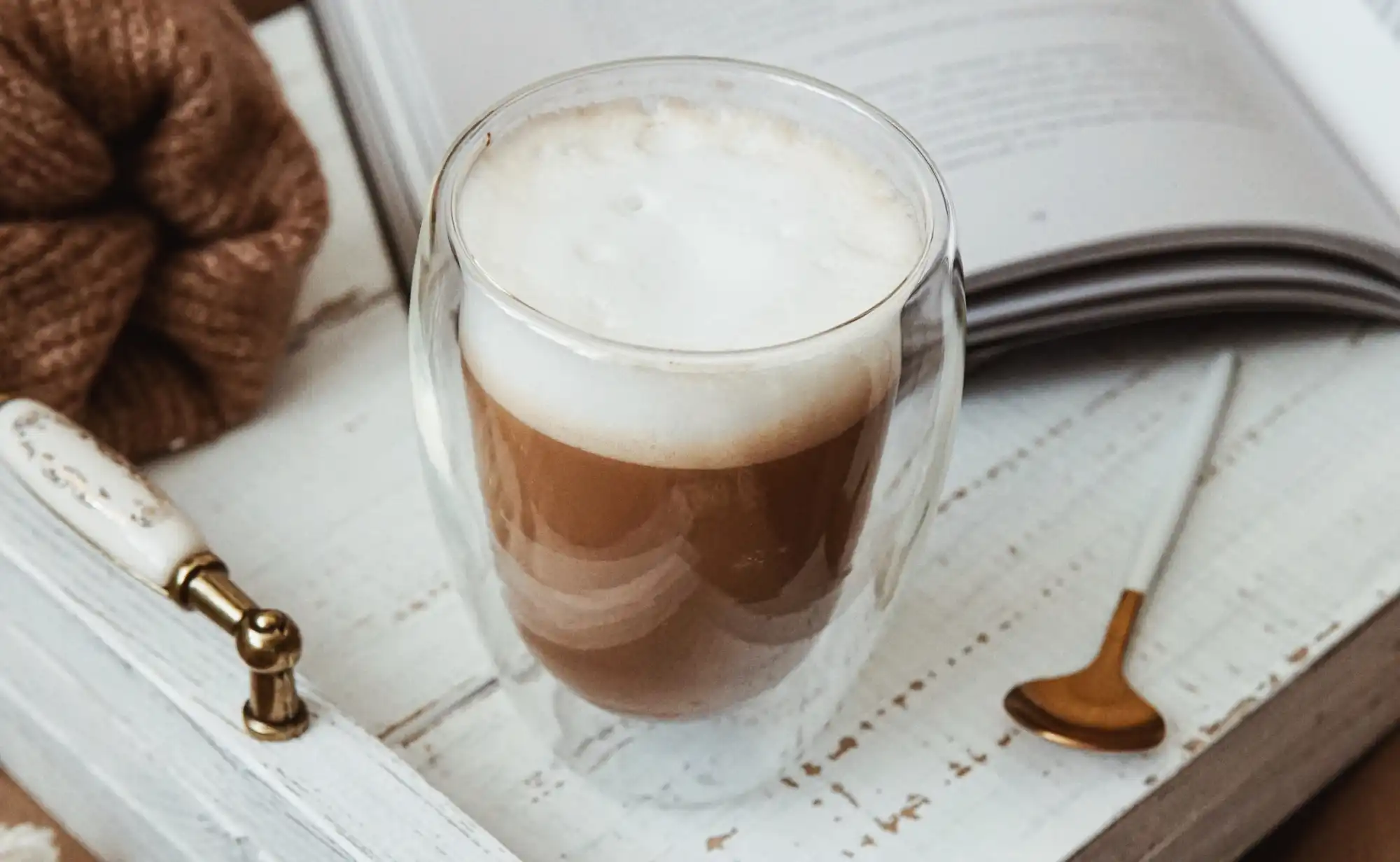
Homemade Latte Recipe Without Fancy Machine
Description
This is a simple homemade latte recipe without fancy machines. What's even better is that you can add different flavors to make a vanilla latte, chocolate latte, and caramel latte according to your preferences.
Ingredients
- 1 oz of espresso-style coffee without an espresso machine
- 4 oz milk, or more
- Flavored syrup, optional
Instructions
- Brew 1 oz of espresso-style coffee, and pour into the cup.
- Pour the milk into a microwave-safe cup. Use the microwave to heat the milk at high for about 1 minute, or until the milk is hot and tiny bubbles form on the edge of the cup.
- Use a handheld milk frother or whisk to foam the milk until it is foamed.
- Use a spoon to hold back the foam on the top of the steamed milk, and pour the steamed milk into the coffee.
- Pour or spoon the remaining foam on the top of the beverage.
- Enjoy immediately.
Notes
Variants
- Dairy-free Latte: Make it with oat milk, soy milk, or almond milk.
- Chocolate Latte: Before heating the milk, add a little chocolate to the milk. According to your preference, 1 tablespoon is a good start.
- Vanilla Latte: After heating the milk, add 1 teaspoon vanilla to the milk. Of course, you can also adjust it according to your taste.
- Caramel Latte: Before heating the milk, add 2 teaspoons of caramel syrup to the milk.
- Iced Latte: Before adding the espresso, fill the glass with ice. Before foaming the milk, add flavoring syrups (optional), no heating.
Nutrition Information:
Yield: 1 Serving Size: 1Amount Per Serving: Calories: 65Total Fat: 2gSaturated Fat: 1gTrans Fat: 0gUnsaturated Fat: 1gCholesterol: 10mgSodium: 68mgCarbohydrates: 7gFiber: 0gSugar: 0gProtein: 4g
Nutritional information is an estimate calculated using a nutrition ingredient database and is not always accurate.
Did you make this recipe?
Please leave a comment on the recipe, share a photo, and tag @roastercoffees. We can not wait to see what you have made!
Here’s how to make a latte without a fancy machine, including the variants in the above recipe and simplified steps, so that you can save and view it easily.
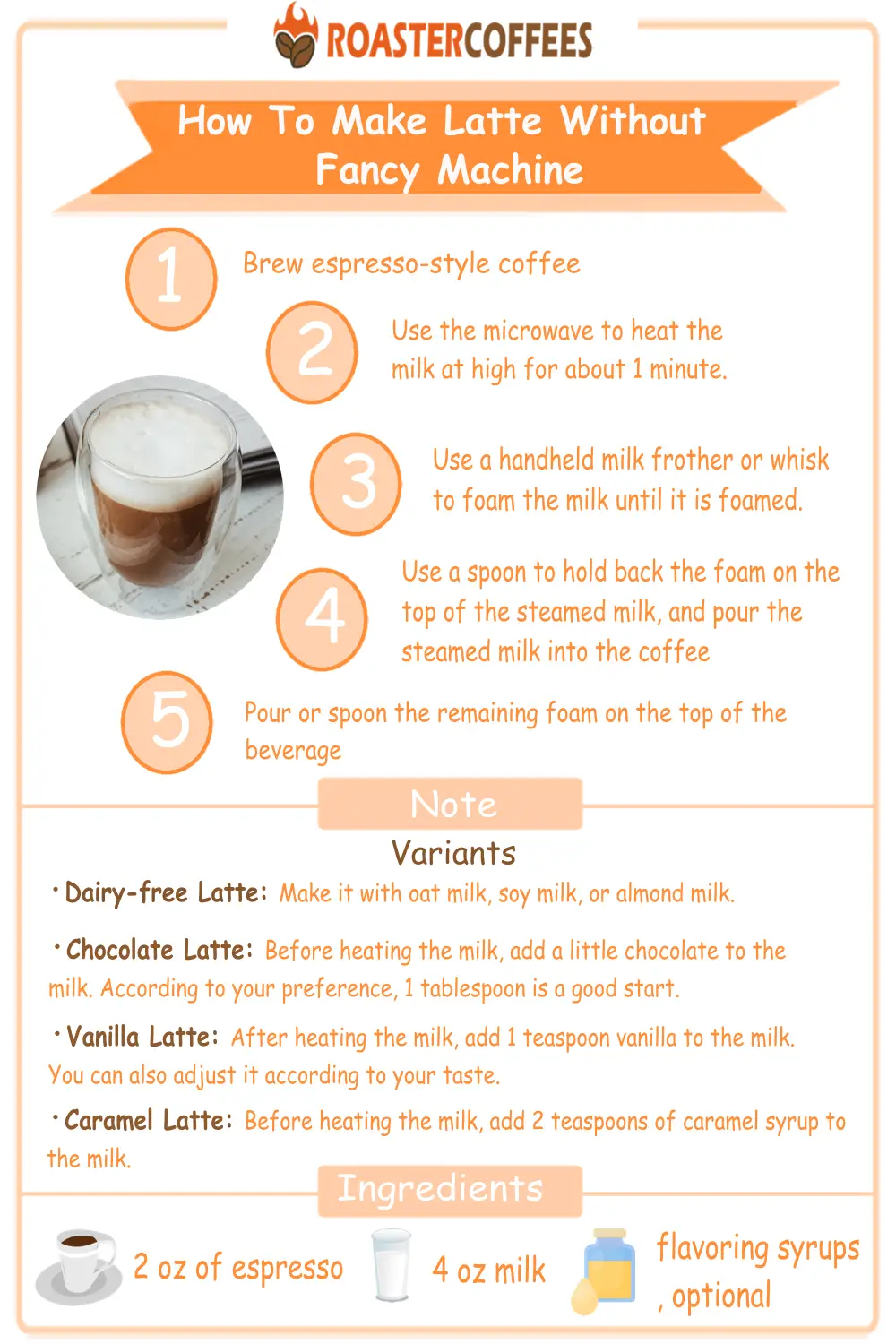
If you want to try the macchiato recipe, please click here.
Final
Now we know the difference between latte vs macchiato. Different brewing methods and ingredients bring different tastes and textures.
If you want to fully enjoy the delicious espresso but want to reduce the bitterness a little, you should try the espresso macchiato. (If you are in a chain, please specify the espresso section).
If you want much less coffee kick, you can order a latte macchiato. It is perfect for people who like more dairy.
Finally, if you want a consistent taste of milk and espresso mixing evenly, or if the latte macchiato doesn’t have enough coffee flavor for you, you can try a latte.
FAQs
Which Has More Caffeine, Latte Vs Macchiato?
The caffeine content depends on the amount of espresso you add. Usually, each espresso shot contains 64 mg of caffeine. So, if you add more espresso, it means more caffeine.
However, please be careful not to exceed 400 mg of caffeine intake per day. It means that four espresso shots are safe, five to six shots stand on the edge of danger, more than six shots may harm your health.
What Is Latte Art?
Latte art is a method of making coffee by pouring microfoam into espresso and forming a pattern or design on the latte’s top layer. It can also be created or decorated by merely drawing the top layer of the foam.
What Is A Mocha?
Mocha is a variant of caffe latte with hot chocolate or chocolate syrup.
The name comes from Mocha, Yemen, one of the centers of the early coffee trade market. The coffee from this area is named mocha coffee, which has an earthy or chocolatey flavor. Now, baristas make beverages that combined chocolate with steamed milk and brewed coffee to become mocha coffee.
Which Is Stronger, Latte Vs Macchiato?
The traditional macchiato (espresso macchiato) has a stronger flavor, while latte macchiato has more milk flavor and is perfect for people who like more dairy. Latte is somewhere between espresso macchiato and latte macchiato.
References
- Mayo Clinic Staff. (29 Feb 2020). “Caffeine content for coffee, tea, soda and more”.
- Diana C. Mutz; Jahnavi S. Rao. (11 June 2018). “The Real Reason Liberals Drink Lattes”.


